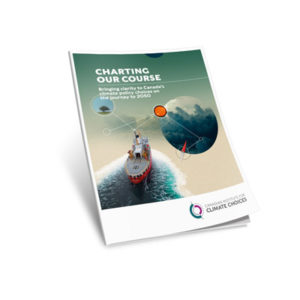Executive Summary
Picture Canada as a ship, and climate change a storm barreling toward us. Already, the seas are becoming treacherous, and the winds threaten to drive us into the shoals. The gathering storm will reshape not just our climate, but also global markets in profound and unpredictable ways. To weather the storm, we must make deliberate choices that lead to cleaner and more inclusive growth, and a resilient and prosperous future for Canada.
Discussion about how to prepare for Canada’s future in the face of climate change is dynamic and ongoing. Canada has joined an increasing number of countries, states, municipalities, and firms setting a goal of reducing greenhouse gas emissions to net-zero by 2050. Some Canadian provinces, territories, and municipalities are establishing their own governance and policy frameworks for long-term emissions reductions.
Yet reducing emissions is just one element of a pathway for Canada to a thriving and prosperous 2050. Yes, Canada must transition to a low-carbon economy alongside the rest of the world. We must also make our communities and infrastructure more resilient to the inevitable impacts of a changing climate, such as more extreme weather and recurring natural disasters. And we must grow the prosperity of Canadians across all regions, all communities, and all socio-economic circumstances.
While these aspirations are clear, the course to that future is not. For many Canadians, climate change remains complex, confusing, and potentially paralyzing. Debates around some climate policy choices—for example, putting a price on carbon pollution—are highly polarized. Debates around others—such as policies that will help us adapt to a changing climate—have received inadequate attention, given the practical benefits it could deliver.
This report tries to bring more clarity to what climate change means for Canada, and the choices we will face. It is a starting point for a deeper, broader, and more constructive conversation about how we can chart a course as a country—through the profound changes ahead—to a resilient and prosperous future with cleaner and more inclusive growth.
Mapping Uncharted Waters

First, the report brings more clarity as to the nature of the challenges and opportunities that climate change presents for Canada. What are the main hazards and conditions on the way to 2050?
Canada faces risk from the physical impacts of a changing climate, including floods, heatwaves, wildfires, and sea-level rise. By 2050, under current trends, the impacts of climate change are expected to reduce global GDP by three percent, or US$7.9 trillion, according to a recent estimate by the Economist Intelligence Unit.
Canada will not be immune. Our coastal cities will be swamped by rising seas, threatening property and infrastructure. In the face of more frequent and more severe fire and floods, insurance premiums are poised to rise dramatically, making home insurance unaffordable for many Canadians. Extreme heat puts Canadians’ health at risk, especially for children, elderly, and other vulnerable populations. Impacts in Canada’s North are particularly severe, including the accelerated loss of local food sources and compromised infrastructure from thawing permafrost. The impacts of climate change internationally will also affect Canada—disrupting supply chains, putting stress on the global economy, and even driving mass migration. Parts of Canada may benefit temporarily from a warmer climate but, if we are unprepared, these benefits will be quickly overshadowed by mounting loss and hardship, particularly for the most vulnerable.
Meanwhile, the rest of the world has begun to respond to the threat of a changing climate by implementing new policies. If this trend accelerates, the implications for global markets—and a small trading state such as Canada—will be dramatic. The faster the world reduces emissions, the faster markets and investors shift away from carbon-intensive goods and services.
That transition poses a different set of risks for Canada. Much of Canada’s economy—and the prosperity it generates—depends on sectors that export emissions- intensive products and commodities, such as oil and gas and cement. If the rest of the world transitions quickly, sharp declines in global demand for fossil fuels would depress the price of oil and lead to lower levels of investment in Canada’s oil and gas sectors. Other sectors face similar risks: Canada’s automotive industry, for example, could see plants close as a result of decreasing demand for gasoline-powered SUVs and light trucks, with vehicle manufacturing shifting to foreign plants that produce electric vehicles.
Yet it also presents opportunities. The World Bank estimates that climate commitments in emerging economies alone will create $23 trillion in investment opportunities between 2016 and 2030. If Canada is prepared, its growing cleantech sector could become a significant source of investment, innovation, and employment. Surging domestic and global markets would create demand for low-carbon innovation, and technologies, goods, and services that reduce emissions. Meanwhile, conventional sectors, such as mining and forestry, could benefit from an unprecedented increase in global demand for raw materials.
Looking ahead, Canada has choices to make about how—and how much—to reduce emissions, adapt to the changes around us, and invest in future economic opportunities. We are a big, northern country with a dispersed population, warming at twice the rate of the rest of the world. We are also a small, trade-dependent economy susceptible to global economic downturns, supply chain disruptions, and fluctuating commodity prices. How we choose to navigate the threats and opportunities presented by those two realities will have profound implications for the next generation of Canadians.
Seeking Safe Passage

Accordingly, this report aims to clarify what it would mean to thrive through climate change. What are the essential elements of safe passage, given the complexities of the risks and opportunities ahead?
Effectively addressing and responding to climate change goes beyond reducing emissions. It’s about affordability. It’s about jobs. It’s about our health and wellness. It’s about protecting wildlife, ecosystems and our drinking water. It’s about preserving the places and things Canadians value today, and the aspects of life in Canada we want to be able to pass on to our kids and grandkids.
The figure below lays out a more comprehensive vision for addressing climate change in a way that contributes to a resilient and prosperous future for Canada with cleaner and more inclusive growth. Put another way, safely navigating the storm ahead requires a healthy and strong crew (thriving Canadians). We need a sturdy and nimble ship (economic prosperity). And we also need to do what we can to calm the waters, working internationally to collectively drive down emissions and dampen the economic and societal shocks of climate change (global action).
Pursuing these goals leads us down a different path than the traditional siloed approach to developing and implementing climate policy. It provides a new, integrated framework for not just weathering the storm, but thriving through the turbulence it brings.
The framework puts the health and wellness of Canadians front-and-centre. This means identifying and proactively addressing health risks. It means supporting and empowering those that are most affected by climate and transition risks, including Indigenous Peoples in Canada. It means preserving the foundation of human life and our economic prosperity by protecting and restoring nature. And it means considering the concerns and needs of youth and future generations when evaluating trade-offs and potential outcomes.

FIGURE EX1:
A New, Integrated Framework of Climate Change Goals and Objectives
The framework also recognizes that the well-being of Canadians is inextricably linked to the strength of Canada’s economy. Economic growth generates jobs and wealth. To maintain economic prosperity through the storm of climate change, the Canadian economy must be well-positioned to compete in shifting global markets. Canadian communities must also be prepared to brace for the direct and indirect risks of a changing climate. Making smart, forward-looking policy choices can achieve these goals at low costs.
Finally, the framework illustrates what we can do to calm the storm. Canada is not powerless to affect the direction or magnitude of global change. We can punch above our weight in influencing global action; indeed, doing so is in our own self-interest. We can leverage Canada’s efforts to reduce emissions and press other countries to do the same. We can also develop good policies at home and share our experiences internationally. And we can develop innovations that make it easier and less costly for others to transition, reducing climate risk for Canada and the world, but also creating opportunities for our most innovative companies.
Steering Through the Storm

Next, the report provides more clarity as to the range of policy choices ahead. What choices can Canada’s municipal, provincial and territorial, and federal governments make to steer and accelerate Canada toward a resilient and prosperous future with cleaner and more inclusive growth?
To start, we can build on successes here at home. For instance, Canada stands out as a global leader in phasing out coal-fired electricity. A combination of federal and provincial regulations will phase out conventional coal-fired power generation by 2030. Ontario led the way through its phase-out, which closed coal plants in the province by 2014. The phase-out has also improved air quality and reduced health risks for people living in the province, increasing the net benefits of the policy beyond strictly environmental outcomes.
Federalism can complicate policy choices, but it also creates opportunities for innovation. Similar to the coal phase-out, many policy innovations in Canada originated at the sub-national level. Saskatchewan was the first to implement carbon capture and storage on a coal-fired power plant. Alberta was the first to implement an output-based pricing system for large industrial emitters. British Columbia was the first to implement an economy-wide carbon tax, Quebec was the first to implement a cross-border cap-and-trade system, and Manitoba was the first to set legislated, five-year carbon budgets. In adapting to a changing climate, the Government of Nunavut has initiated risk mapping and new infrastructure standards to reduce the impacts of permafrost thaw. The Governments of the Yukon and Northwest Territories are collaborating to develop community clean air shelters to reduce health impacts from wildfire smoke. And Atlantic provinces are working together to provide communities with online tools to support rural coastal adaptation.
Municipalities also have a clear role to play. Montreal, for example, tracks heat-related deaths. This tracking has allowed the city to identify correlations between deaths and low-income neighbourhoods as well as areas that lacked tree cover and greenery. This information has been critical in developing an integrated plan to address risk. In 2019, Montreal committed to extend the hours of pools, libraries, community centres and homeless shelters during heatwaves. Fire safety workers also go door-to-door to check on people flagged as vulnerable, hand out water bottles to the homeless, and encourage citizens to stay cool and hydrated. In addition, the city is planting more trees to help reduce the urban heat island effect.
We can also learn from best practices internationally. Melbourne, Australia, for example, uses a series of lagoons to treat half of the city’s sewage. The plant eliminates greenhouse gas emissions by using lagoon covers that collect biogas for electricity production. At the same time, it creates other ecological and economic benefits. The natural plant produces 40 billion litres of recycled water a year and is energy self-sufficient. It is also an internationally significant wetland for waterfowl, with over 280 bird species identified at the plant.
We must increase the overall ambition of our collection of policies beyond current levels to navigate the course to 2050. Although Canadian governments have made progress, the scope of policies—in terms of the sectors, regions and issues covered—has been far too limited. Too few Canadians, for example, have access to clear flood risk maps that would help them prepare for emergencies and plan their investments. Action to protect and restore wetlands has also tended to be localised and ad hoc, rather than part of a broader strategy or plan. And we still have work to do to achieve our national emissions-reduction targets.
Charting Our Course

Change brings risk. But it also brings new opportunities— if we are prepared to seize them. The choices we make today will shape our future. That should give us hope: our actions can directly influence how climate change ultimately affects our children, our communities, and our country.
Even in the face of global changes beyond our control, Canada’s climate choices matter. Yet successfully navigating the turbulent waters ahead will rely on strong leadership, openness to new ideas, willingness to collaborate, and innovative thinking. Below, we propose four broad next steps for Canadian policy makers on climate change to set us on course.

Recommendation #1:
Canadian governments should broaden objectives for climate policy
Historically, governments have focused on relatively narrow objectives (achieving emissions-reduction targets, managing specific climate risks). Yet we have often failed to deliver on these objectives, and we remain largely unprepared for future challenges. A broader perspective on policy design—looking beyond the narrow lenses of mitigation, adaptation, and clean growth—can help to clarify what governments are trying to achieve, embed climate change objectives in all policy choices, and guide more innovative policy solutions. By linking objectives more directly to the welfare of Canadians, this approach can also build a broader coalition of support for action.
Canadian governments—at all levels—have roles to play in delivering a future Canada that is resilient to the changes ahead, for our climate and our economy.
Recommendation #2:
Canadian governments should embrace Canada’s role in global outcomes
Canada has the potential to influence global change, rather than merely respond to it. We are among the largest economies in the world and have a seat at the table of global leadership through organizations such as the United Nations, G7 and G20. We are also one of the world’s largest emitters. We should think strategically about what we can do to drive the action needed to produce better global outcomes. For example, we can demonstrate global leadership through our own actions, we can work internationally to help solve policy challenges that are driving global risks, and we can develop technologies and products that make transition easier and more cost- effective—while realizing economic benefits and new opportunities for Canadian businesses and workers.
Recommendation #3:
Canadian governments should expand the scope, scale, and pace of climate policies
It is not enough to just develop policies aimed at addressing climate change. The policies must also have sufficient ambition. This means expanding the coverage of policies across regions, issues, and sectors, ramping up the magnitude of change, and tightening the timeframe for achieving results. We need to think about where we want to be in 2050 and beyond,
and work backwards to determine optimal pathways and choices. Decisions made today should lay the groundwork for long-term success. Canada has made considerable progress in the last decade, but overall action has not been commensurate with the scale of the challenges ahead.
Recommendation #4:
Those analysing and developing policy options should seek out integrated solutions that drive multiple benefits
The complexity and multi-dimensional nature of climate change, combined with the need for greater ambition, demands a more integrated and comprehensive approach to finding solutions. The most effective policies will achieve multiple benefits across a range of climate change and other policy objectives. But the best way to identify and develop these policies is by breaking down traditional policy silos and bringing people with different expertise, backgrounds, and perspectives together.
Charting a course to a resilient and prosperous future for Canada with cleaner and more inclusive growth is possible. To do so, we need more clarity on the nature of the challenges and opportunity along the way. We need clarity as to how we measure our progress along the course. And we need clarity about the choices—and their implications—that we can make to steer toward better outcomes for Canada.
Ultimately, however, charting a course is only a first step. Research organizations such as the Canadian Climate Institute can support Canada’s journey to 2050 and beyond by bringing together top experts from a range of disciplines to analyse pathways, evaluate policy options, and point to solutions that serve the best interests of current and future generations of Canadians
While this report frames important new policy and research questions, answering those questions, and putting practical solutions into action will require hard work from a broad group of Canadians and governments at all levels. It will require all hands on deck.

